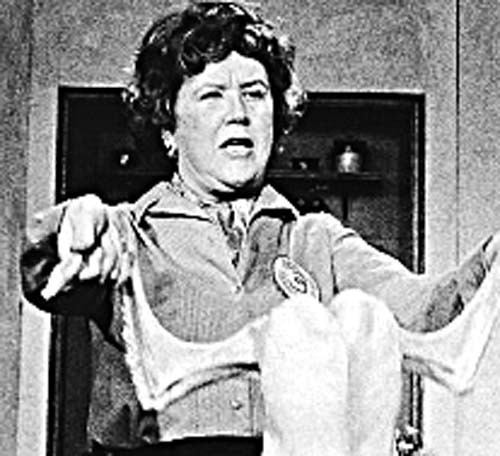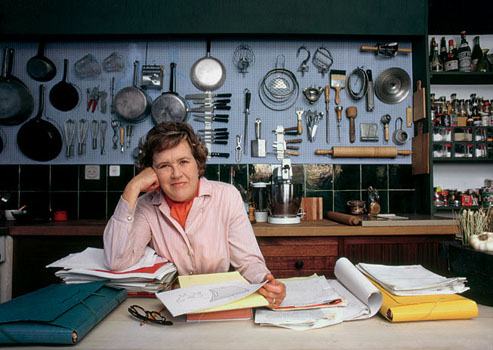So, with my recent illness, I spent a goodly portion of my holiday weekend lying on the couch watching TV. And, the only thing drifting through my mind most of that time was Bruce Springsteen’s song from 1992’s Human Touch album entitled 57 Channels (and nothin’ on). (Yes, mom, I finally got a Bruce reference in for ya!)
Fortunately, I had a few other diversions to occupy my time. I read a book about the Apollo program, brushed up on a few tool manuals I had neglected to read and I surfed for online movies. Yup, I was putting my Netflix subscription to the test!
Love ’em or hate ’em, Netflix is one of the largest players in the online DVD rental and streaming video world. And, as I glanced through the offerings, there was plenty of material to choose from. Action movies. Sci Fi. Comedies. Classics. While I was searching for movies, I came across one called Julie and Julia I had seen last summer. This 2009 movie told the story of Julia Child as she struggled to interpret archaic French recipes, and the story of Julie Powell, a blogger who set out to cook every recipe in Child’s classic work Mastering the Art of French Cooking.
Why did this movie stick out for me? Well, as far as I can tell, it’s the only movie that is based around the struggles, trials and successes of a blogger. The other part was the towering achievement Julia was able to make reality. The movie showed in great detail how this one time OSS operative (Yes, she was a spy!) during World War II had to struggle to merely be accepted as a student at the prestigious La Cordon Bleu culinary academy. Her work in bringing these arcane cooking techniques to American kitchens was a seminal moment for home chefs and foodies. Yes, people who list cooking as a hobby owe much to Julia’s determination.
Why bring this up? As you can imagine, there are many lessons that a woodworker can learn from Julia Child. For instance:
- Method is essential. If you are going to make Hollandaise sauce (one of the five French mother sauces), should you melt the butter and pour it in to your egg yolk and lemon juice mixture? What if you put the butter in cold and stir off the heat? How about using more lemon juice? These may seem like trifling details, but they can mean the difference between a rich sauce that will make your Eggs Benedict the stuff of legends and bringing an oil slick to the dinner table. The same thing goes for woodworking – should you cut your dovetails before or after the final sanding of each component? What order should you glue up that complicated project so you don’t get yourself into a sticky situation? When you think your process through, you can save yourself a lot of headaches later.
- Make the most of everything. “Save the liver!” Oh, how I laughed when Dan Aykroyd lampooned Julia on Saturday Night Live. While it was a funny sketch, the lesson was profound. Chicken livers could be saved and made into pate. Bones from cuts of meat could later be boiled down to a rich stock – or, even better – a demi glace that can transform a ho-hum meal into a dish you would be proud to serve your guests. This one’s easy to take to the shop. If you leave a larger offcut, be sure to stash that sucker somewhere you can get to it later so you can build something smaller. Look at your tools as multi-taskers… how much more can you get out of your table saw or plunge router? if someone is throwing out an old piece of furniture that has seen much better days, maybe saving the classic pulls, knobs and hinges would help make your next project something special.
- Nothing is insurmountable. Just imagine sitting down to learn all of the intricacies of French cooking. Now, go beyond that and attempt to take these centuries old techniques and methods and translate them for the average American kitchen. When no one who is instructing you believes that 1) you can do it and 2) that it should even be done in the first place. So, when you balk at cutting your first mortise and tenon joint, making those dovetails or building your own doors for a project, why let something as simple as ‘I’ve never done it’ get in the way? Just remember, someone had to go down to the water’s edge, grab a craggy looking stone-like animal with sharp edges from a reef, break it open, look at the glistening sliminess, scarf it down and say, “Hey, I think oysters taste delicious! Who’s going to invent Champagne?”
- Enjoy the final product. During the production of The French Chef (one of the first cooking shows on television), Julia would whip up some exotic recipes from her masterpiece. She did the show live to videotape (the woman had some serious guts to have attempted that), flubs and all – to show how to prepare those sumptuous dishes. And, just before the credits would roll, she would turn to the camera, her face beaming with her trademark smile, and bid her viewers farewell with a cheerful “Bon Appetit!”. I often find myself at the end of a project eager to get it out of the shop and off to the client. But, that’s just so anticlimactic. One thing I’m going to start doing more is to take the time to appreciate that final piece. Take pictures of it. Run my hands over the smooth surface one more time. Just notice what I have built and appreciate how happy it’s going to make the client. That’s why I got into woodworking…
As for me? Well, I’m more of an Italian food guy myself.. but, I’m giving serious thought to changing the approach I take to my work. Ya know, that French chef really knew her stuff.



Great post Tom! I have always thought that cooking and woodworking were very close in spirit and in practice. The only difference is that in woodworking you project can last for generations. In cooking, they last until a hungry stomach wanders by.
Jonathan
=============================
Tom- great post…I’m an old cook and a much newer woodworker. I’ve long said about cooking that the keys are – technique and ingredients. Having good ingredients and handling them properly makes all the difference in the quality of the meal. Of course, I’ve also found cooking to be engaging and creative.
So now I’ve got woodworking – and it feels engaging and creative and it seems to be about technique and ingredients. I find a lot of correlations between the two practices. Though generally, woodworking is more relaxed because, at least for me, it takes longer – days and weeks – instead of minutes and hours with cooking. With cooking, every day is another meal and another opportunity for fun and eating. Woodworking is slower, but then the end product is more or less permanent.
I think my cooking background has served me well as I’ve begun woodworking…an understanding of the value of the ‘ingredients’ that go into the project and the need to practice and prepare for the techniques required.
A “French Cooking / Woodworking Souffle” !
Man, you have to stop mixing Day Quill and Benadryl together ! lol
(only kidding Tom)
Julia Childs was the cooking version of Norm !
Great post Tom.
Glad you are feeling better.
It’s all that codeine cough syrup the doc prescribed! 😛